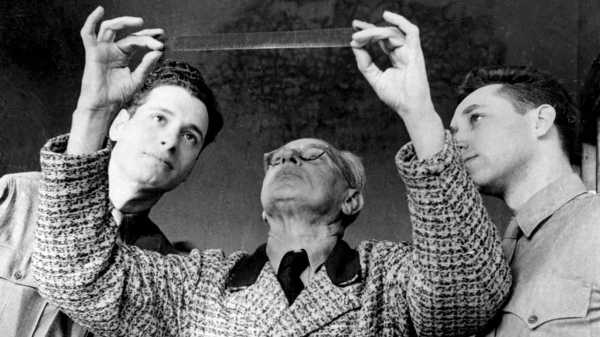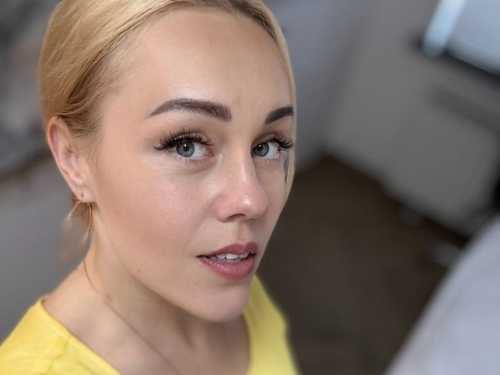
Save this storySave this storySave this storySave this story
There is a point in Jean-Christophe Klotz’s documentary “Filmmakers for the Prosecution” when the producer Sandra Schulberg describes emptying out the New York City loft where her mother, Barbara, lived until 2002. Under a daybed, Schulberg and her siblings found boxes of documents concerning the first Nuremberg trial of prominent Nazis, held after the end of the Second World War, in 1945 and 1946. Looking further, Schulberg discovered a 16-mm. film titled “Nuremberg: Its Lesson for Today.” The film was on a corner shelf, and people had been using the cannister as a party coaster, she tells Klotz, “putting their wine glasses on it.”
The film was a print of a Nuremberg documentary made by Sandra’s late father, Stuart, which had been commissioned by the War Department and showed Nazi political and military leaders in the full light of the atrocities they’d committed during the war. By the time the film was finished, in 1948, however, its point of view conflicted with the United States’ new Cold War priorities, which included recruiting some of those same Nazis to the Allied cause. The documentary was denied release by Kenneth Royall, the Secretary of the Army. Before Schulberg found the copy in her mother’s loft, her father’s film had never been shown in theatres in the United States.
The discovery of the Nuremberg material became an obsession for Schulberg, who knew little about either Nuremberg or her father’s important role there. “I was tabula rasa,” she told me. She subsequently restored the Nuremberg documentary in partnership with Josh Waletzky, had it translated into thirteen languages, and disseminated it widely. The restored film reached Klotz in France. He had made two acclaimed documentaries about Rwanda; during an early reporting trip, he’d been shot in the hip by Hutu militiamen and almost lost his leg. It took Klotz time to realize that his repeated trips to Rwanda, and his calling to show the horrors of ethnic cleansing, had to do with his family’s Second World War history. Klotz’s grandfather, a Jewish physician from Alsace, was an Auschwitz survivor. As a seventeen-year-old, Klotz’s father, Georges, joined the French Resistance and fought against the Nazis until the end of the war, at which point he decided to work in film. In the early fifties, he attached himself to a Marshall Plan film program based in Paris that was overseen by Stuart Schulberg, who became his mentor.
The Schulberg family is a storied one in Hollywood. B. P. Schulberg—Stuart’s father—had been the chief of production at Paramount in the late twenties and early thirties. He’d produced more than a hundred films and introduced Clara Bow, the original It Girl, to the American moviegoing public. In 1941, B. P.’s son Budd—Stuart’s older brother—saw his novel “What Makes Sammy Run?,” which excoriated Hollywood’s lack of morality, published. He went on to write the screenplays for “On the Waterfront,” “A Face in the Crowd,” and other films. Stuart, after his postwar exploits in Europe, returned to the United States and eventually became the long-running producer of the “Today” show.
Klotz had long wanted to tell Stuart Schulberg’s Nuremberg story, and, after he received a copy of his documentary that his daughter had restored, he approached Sandra about collaborating on a film. Klotz knew that both Stuart (a Marine sergeant) and Budd (a Navy lieutenant) had worked for the Office of Strategic Services’ Field Photographic Branch under the famous director John Ford, who had stacked his O.S.S. film division with Hollywood filmmakers and technicians. At the war’s close, Ford and his O.S.S. boss, William (Wild Bill) Donovan, embarked on a desperate race to collect film and photographic evidence of Nazi atrocities. Donovan, who was a lawyer and helped plan the Nuremberg prosecutions, hoped to use the Nazi film archives as evidence of criminal deeds. But, by the summer of 1945, Nazi sympathizers were destroying evidence as fast as they could locate it.
Recruited to Field Photo, as it came to be known, Stuart arrived in Germany in July of 1945 with a mandate to collect as much visual evidence of Nazi crimes as he could before the opening of the first Nuremberg trial, then scheduled for mid-September. Budd arrived later, at the beginning of August. At twenty-two, Stuart was the youngest member of the Field Photo team and wrote almost daily letters to Barbara back in the United States. These letters were part of the trove that Sandra found in her mother’s apartment. Klotz quotes them extensively in the film. In one letter, Stuart writes, “Sometimes I think the job is a few sizes too big for me. I suppose I’ve never had so much responsibility. There’s so much to do, and so much of it is so important that I grow terrified.” In another, he writes, “The job is so damned important and so many big people are counting on us and expecting us to do our part. Unless something happens quickly, we’re going to foul up the biggest assignment Field Photo ever got.”
Klotz’s film records a race pitting the Schulbergs and the rest of Ford’s Field Photo unit against what seemed like a residual German command structure that was systematically destroying evidence. In one instance, the Field Photo team received a tip about a secret cache of Nazi footage at the bottom of a deep salt mine in Lower Saxony, only to arrive there and find “acres of films—football fields of film,” as Budd put it, still smoldering after it had been burned. Another cache, in a building outside Berlin, had similarly been torched just prior to the arrival of Field Photo.
Finally, the team learned of a collection of Nazi films in the old U.F.A. film studio in the Berlin suburb of Babelsberg, where, before the war, films including “The Blue Angel” had been made. The Babelsberg studio, however, was in the Soviet sector, and the Soviet officer in charge, Major Georgy Avenarius, couldn’t understand what a group of young American officers led by Budd Schulberg wanted with the Nazi films that he was charged with protecting. In an interview late in life, Budd recalls explaining to Avenarius that “it’s a long story, Major, but we are part of Commander John Ford’s—”
Major Avenarius cut him off. “John Ford? You know John Ford?
“He’s our boss,” Budd responded.
Avenarius told Budd he’d written extensively on John Ford.
It turned out, Budd Schulberg recalls, “that this man was the greatest expert on John Ford in the world.”
“Bring a truck,” Avenarius said. “Take anything you want.”
The structure of the Nuremberg trial was the result of complicated postwar negotiations between the Allies. Stalin and Churchill wanted to simply execute leading Nazis, but the American team—led by Robert H. Jackson, a legal visionary on leave from the Supreme Court—wanted to use the trial to create the cornerstone for a new era of international law. Among other important principles, Jackson entered into world jurisprudence the legal concepts of crimes against peace and crimes against humanity. The Nuremberg trial also introduced the principle that individual politicians and members of militaries could be held responsible for crimes committed by their states. Jackson hoped that this last principle would be a significant deterrent to future state crimes.
Jackson was adamant that the Nuremberg trial be accessible to the press and the public—both because he wanted to show the world that the defendants had been treated fairly and also because he wanted the German and international publics to know about the atrocities that the Nazis had committed. Jackson asked Field Photo to present two films at the trial. The first was scheduled for November 29, 1945, ten days after the trial’s opening. Titled “Nazi Concentration Camps,” it featured an hour-long compilation of film footage taken when the Americans and the British liberated the camps. The trial defendants were directly and publicly confronted with images of starved inmates, emaciated, lime-covered corpses, charred human remains stacked on crude crematoriums, piles of bodies pushed by bulldozers into trenches. The courtroom impact, shown in Klotz’s film, is stunning. When the lights come up, Wilhelm Keitel, a field marshal and the head of the German Armed Forces High Command, is wiping tears from his eyes. Hans Frank, the governor-general of occupied Poland and a man accused of killing millions of Poles, stares into space—also near tears. Most notably, Rudolf Hess, who had spent the war in British prisons and had been effectively feigning amnesia, came in to court the next day and said he took full responsibility for everything he’d done, stating that his memory was “once more available” and that his amnesia had been “for tactical reasons.”
The second film, “The Nazi Plan,” was shown on December 11th, less than two weeks later. It ran three hours and fourteen minutes—and made the case that both the war and the atrocities committed by the Party were premeditated. To help make the film’s argument, the Schulbergs and the Field Photo unit had tracked down and interrogated both Leni Riefenstahl and Heinrich Hoffmann, Hitler’s official photographer, each of whom proved more than willing to rat out their Nazi colleagues.
The Nuremberg trial lasted almost a year. The defendants were convicted on the basis of the reams of evidence collected by Jackson and his team. Ten defendants were condemned to death and hanged in the Nuremberg gymnasium sixteen days after their verdicts were announced. The group included Keitel, Frank, Rosenberg, Joachim von Ribbentrop, and General Alfred Jodl, who had surrendered the German forces to the Allies just seventeen months earlier. Hermann Göring managed to commit suicide the night before his sentence would have been carried out.
The shocked reactions of the defendants to Field Photo’s evidentiary films could have been feigned, Eli Rosenbaum, a long-term Justice Department investigator and prosecutor of human-rights violations who appears in Klotz’s film, told me. But television hadn’t yet been widely adopted, he added, and it’s likely that most of the defendants had never been directly confronted with immediate visual evidence of the horrors that they had perpetrated. Rosenbaum spoke to me about how important the photos and films collected by the O.S.S. team had been in establishing the shared perception of the Holocaust; in the film, he notes that the written word was “absolutely inadequate” to describe the extent of the Nazi reign of terror and that “the only compelling way to do that was through film.”
Stuart Schulberg did not begin work on his documentary—the one that would become “Nuremberg: Its Lesson for Today”—until the trial was over. The intention of the film was to show how the case against the Nazi leaders had been built and prosecuted. But because the documentary was made under the auspices of the War Department, Stuart had to rely on footage shot by the understaffed and politicized Army Signal Corps. The documentary itself soon became mired in the new politics of the Cold War and was never released in theatres in the United States. At a time when the American military was beginning to recruit former Nazis to help the U.S. in its standoff with the Russians, the Americans did not want to circulate a film that further demonized the Germans—particularly those in the military. “A great opportunity was lost,” Rosenbaum observes in Klotz’s film, “to educate Americans and to remind them of what we fought for.”
Rosenbaum was recently appointed by Merrick Garland to lead the Justice Department’s War Crimes Accountability team for Ukraine. He characterized Nuremberg to me as “the mother of all modern-day human-rights prosecutions,” and ends the film by noting how tragically prescient Jackson was when he wrote that the Nuremberg defendants were “living symbols of racial hatred, terrorism, and violence, and of the arrogance and cruelty of power.” These are, Rosenbaum continues, “the very same problems that we deal with today. The world has not changed as much as the dreamers who brought us the Nuremberg trial thought it would.” ♦
Sourse: newyorker.com






